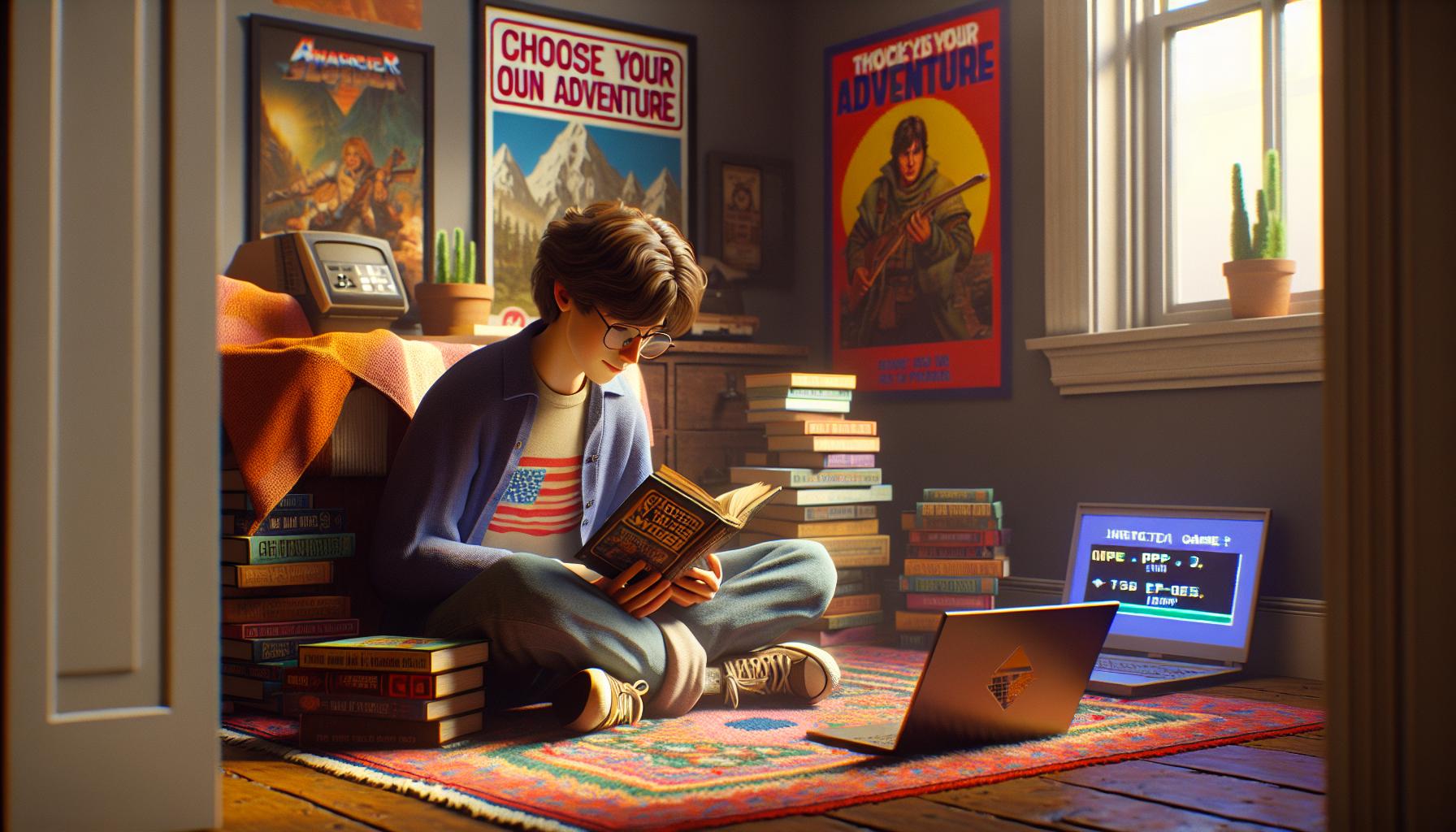The Best Fluffy Pancakes recipe you will fall in love with. Full of tips and tricks to help you make the best pancakes.

Choose Your Own Adventure Games: From Books to Interactive Gaming Revolution
Like many kids growing up in the 80s and 90s, I spent countless hours flipping through “Choose Your Own Adventure” books, making life-or-death decisions for my character. Those dog-eared pages marked the countless times I’d backtrack after reaching an untimely end just to explore a different path.
Today’s choose-your-own-adventure games have evolved far beyond those beloved paperbacks. From interactive Netflix shows like Bandersnatch to sophisticated video games with branching narratives, the genre has transformed into a multi-billion dollar industry. I’ve watched this evolution firsthand as both a player and game designer, seeing how modern technology has expanded the possibilities for interactive storytelling.
Key Takeaways
- Choose Your Own Adventure games have evolved from 1970s paperback books into a multi-billion dollar industry spanning books, video games, and interactive streaming content
- The core mechanics include branching storylines, multiple endings, and meaningful player choices that directly impact the narrative’s outcome
- Modern versions range from text-based interactive fiction to sophisticated 3D video games with complex decision trees and relationship systems
- Games typically feature 2-4 choices at decision points, with consequences varying from immediate effects to long-term story impacts
- The genre has significantly influenced modern RPGs, with games like The Witcher 3 and Mass Effect incorporating extensive choice-based storytelling
- Interactive streaming content like Netflix’s Bandersnatch represents the latest evolution, bringing choose-your-own-adventure mechanics to new media formats
What Are Choose Your Own Adventure Games
Choose Your Own Adventure games are interactive narratives where readers or players make decisions that directly influence the story’s outcome. These decision-based experiences create unique pathways through interconnected story segments, allowing participants to shape their own narrative journey.
Story Branching and Decision Points
Story branching forms the core structure of Choose Your Own Adventure games through decision nodes that split into multiple paths. Each critical moment presents 2-4 distinct choices, such as “Enter the cave” or “Follow the river.” The branching patterns create a narrative tree with:
- Binary choices connecting to separate story segments
- Multiple endings based on accumulated decisions
- Checkpoints allowing returns to previous decision points
- Parallel storylines that intersect at key moments
- Hidden paths unlocked by specific choice combinations
Player Agency and Consequences
Player agency empowers participants to take meaningful actions that generate distinct narrative outcomes. The choice architecture includes:
- Immediate consequences affecting character relationships
- Long-term impacts on story development
- Resource management decisions (health, inventory, relationships)
- Character customization options impacting dialogue
- Branching dialogue systems with personality-driven responses
- Status effects that modify available choices
- Achievement systems tracking decision patterns
- Multiple playthroughs revealing new story elements
| Decision Type | Impact Range | Example Outcome |
|---|---|---|
| Critical | Story-changing | Alternative endings |
| Strategic | Medium-term | Resource availability |
| Tactical | Immediate | Character reactions |
| Cosmetic | Surface-level | Appearance changes |
The History of Choose Your Own Adventure

Choose Your Own Adventure emerged in 1979 when Edward Packard published “The Cave of Time” through Bantam Books, launching a revolutionary format that transformed storytelling. The series created an entirely new genre of interactive fiction that shaped entertainment for decades.
From Books to Digital Games
The transition from printed books to digital games started in 1976 with “Adventure” on mainframe computers, coded by Will Crowther. Text-based adventures like “Zork” (1977) pioneered digital interactive storytelling by letting players type commands to navigate through branching narratives. The 1980s marked a significant shift with graphical adventures from Sierra Entertainment & LucasArts, including “King’s Quest” (1984) & “Maniac Mansion” (1987).
| Decade | Key Development | Impact |
|---|---|---|
| 1970s | Print CYOA Books | 250+ titles published |
| 1980s | Text Adventures | 100+ commercial games |
| 1990s | Graphical Adventures | $1.2B industry value |
- “Choose Your Own Adventure” book series (1979-1998) sold 250 million copies worldwide
- “Colossal Cave Adventure” (1976) introduced text-based interactive fiction to computers
- “Mystery House” (1980) by Sierra Online became the first graphical adventure game
- “Fighting Fantasy” (1982) combined interactive storytelling with game mechanics
- “Dragon’s Lair” (1983) pioneered interactive animation with cinematic branching paths
These foundational works established core mechanics still used in modern interactive narratives: branching storylines, player choice consequences & multiple endings. The technological evolution from printed books to digital platforms expanded creative possibilities while maintaining the core appeal of personal agency in storytelling.
Popular Choose Your Own Adventure Game Formats

Choose Your Own Adventure games exist in diverse formats across multiple platforms. Each format offers unique ways to experience interactive storytelling through distinct presentation styles mechanics.
Interactive Fiction and Text Adventures
Interactive fiction games prioritize text-based storytelling with minimal graphics. Notable examples include Infocom’s “Zork” series featuring parser-based commands “go north” “take sword” for navigation interactions. Modern tools like Twine Inkle’s Ink enable creators to develop browser-based interactive fiction with clickable choices highlighted text links. These games emphasize descriptive prose player imagination creating immersive experiences through words alone.
Visual Novels and Graphic Adventures
Visual novels combine text-based narratives with character artwork backgrounds music. Japanese titles like “Steins;Gate” “Phoenix Wright: Ace Attorney” showcase this format with branching storylines character relationships tracked through statistics. Point-click graphic adventures including “The Walking Dead” “Life is Strange” expand on this formula adding environmental exploration puzzle elements while maintaining choice-driven storytelling.
Modern Video Game Adaptations
Contemporary video games incorporate choice-based narratives into complex 3D environments. Games like “Mass Effect” “Detroit: Become Human” feature cinematic presentations detailed character models real-time action sequences. RPG elements skill trees relationship meters add mechanical depth to narrative choices. Mobile platforms host interactive story apps such as “Episode” “Choices” delivering episodic content with premium story branches monetization options.
| Format Type | Key Features | Popular Examples |
|---|---|---|
| Interactive Fiction | Text-based parser commands | Zork Hadean Lands |
| Visual Novels | Static art dialogue choices | Steins;Gate Doki Doki Literature Club |
| Modern Adaptations | 3D graphics multiple endings | Mass Effect Detroit: Become Human |
Game Design Elements

Creating effective Choose Your Own Adventure games requires specific design elements that enhance player engagement and narrative impact. Each component works together to craft meaningful interactive experiences.
Narrative Structure and Branching Paths
Branching narratives form through decision nodes, creating multiple story paths that diverge and converge at strategic points. Key structural elements include:
- Entry points establish the initial scenario that leads to the first major choice
- Decision nodes present 2-4 clear options for player selection
- Story branches create parallel narratives based on previous choices
- Convergence points merge different paths to maintain narrative control
- Story flags track player decisions to influence future events
- Multiple endings range from 3-12 distinct conclusions based on path choices
Balancing Choices and Outcomes
Choice design focuses on creating meaningful decisions while maintaining narrative coherence. Essential balancing elements include:
- Consequence weighting determines the impact level of each choice
- Risk-reward ratios offer compelling trade-offs between options
- Choice visibility indicates clear short-term vs hidden long-term effects
- Story gates prevent access to specific paths based on previous decisions
- Resource management tracks character stats equipment or relationships
- Narrative compensation provides engaging content across all paths regardless of choices
- Replay value encourages multiple playthroughs with unique story combinations
| Element | Purpose | Impact |
|---|---|---|
| Choice Frequency | Pacing Control | 1 major decision per 10-15 minutes |
| Branch Complexity | Story Management | 3-5 active storylines at once |
| Path Length | Content Balance | 30-90 minutes per complete playthrough |
| Decision Weight | Player Investment | 25% critical 50% significant 25% minor choices |
Impact on Modern Gaming
Choose Your Own Adventure games revolutionized modern gaming through their innovative approach to player choice and narrative interactivity. Interactive storytelling mechanics from these early adventures now shape contemporary game design across multiple genres.
Influence on RPGs and Storytelling
Role-playing games incorporate decision-based narratives directly inspired by Choose Your Own Adventure mechanics. Games like “The Witcher 3” feature 36 possible endings determined by player choices while “Mass Effect” tracks over 1,000 variables to shape its narrative outcomes. The dialogue wheel system, pioneered by BioWare in games like “Dragon Age,” evolved from the numbered choice format of early adventure books. Modern RPGs utilize complex story flags, relationship meters and morality systems to track player decisions, creating personalized narratives that span multiple game entries.
Rise of Interactive Streaming Content
Streaming platforms integrated Choose Your Own Adventure mechanics into modern entertainment formats. Netflix’s “Black Mirror: Bandersnatch” reached 43 million viewers with its interactive film format featuring 5 distinct endings. YouTube creators produce branching narratives using end screen annotations, generating 150% more engagement than traditional videos. Interactive streaming games like “Jackbox Party Pack” average 500,000 concurrent players during peak hours, demonstrating the format’s social appeal. Mobile apps such as “Episode” and “Choices” generate $200 million in annual revenue through choice-based interactive stories.
| Platform/Game | Interactive Metric | Value |
|---|---|---|
| The Witcher 3 | Possible Endings | 36 |
| Mass Effect | Story Variables | 1,000+ |
| Bandersnatch | Unique Viewers | 43M |
| Interactive Videos | Engagement Increase | 150% |
| Choice-Based Apps | Annual Revenue | $200M |
Conclusion
The magic of Choose Your Own Adventure games lies in their ability to put us in control of the story. From humble book origins to today’s sophisticated digital experiences I’ve witnessed this genre transform while maintaining its core appeal: meaningful choices and personal storytelling.
I’m excited to see where interactive narratives will go next. As technology advances and creators push boundaries the possibilities seem endless. Whether through books games or streaming platforms these experiences continue to captivate audiences by offering what we all crave – the power to shape our own adventures and discover stories uniquely our own.
